An Ode To Ghee
Is ghee a superfood?
That’s what the wise folks who issue food diktats from time to time say. (Too much salt’s bad for you! No dammit, it could be good for you!) They say that far from being a lethal, artery-clogging, adipose-adding substance, ghee is actually great for your health. In fact, ghee’s place is now up there amongst such allegedly miraculous superfoods as quinoa, açai berries, chia seeds, kale and so on.
Now, I don’t know if ghee is a superfood. What I do know is that I have always considered it to be a SUPER food. Super as in yummy. Super as in oh-please-I-want-some-more!
So I like to have a little ghee with my steamed rice once or twice a week. Indeed, one of my all-time favourite comfort foods is plain ghee-bhaat — piping hot steamed basmati rice with a bit of good quality ghee and a pinch of salt. I’ve always felt guilty about this little indulgence of mine. But thanks to ghee’s recent elevation as a nutritional rockstar, I feel much better about it now.
And yes, I do add a spoonful of ghee to a lot of stuff I make. Dishes such as the Bengali chholar (chana) dal or muger (moong) dal, khichuri, mocha ghonto (banana flower veggie), dhonka (curry made with savoury lentil dumplings), enchor (jackfruit curry), or even the humble potoler dalna (parwal curry cooked the Bengali way) take on an extra dimension when finished with a bit of ghee. Again, pulaos must be cooked entirely in good quality ghee. Cheat and cook with any other fat (adding a bit of ghee later) and it’s fried rice — not a pulao.
My association with ghee goes back to my earliest childhood. Ghee used to be made at home. I remember my mother would boil and simmer the milk till it threw up a nice layer of cream, or shaur, as we call it in Bengali. When the milk was left in the fridge overnight, the cream got thick as a paratha. It was tempting stuff, that cream was, and tasted particularly scrumptious when had with a bit of gur. But I mostly resisted the urge to scoop it out and eat it because it held the promise of an even more tempting delight — ghee.
The cream used to be collected for 10-14 days and kept in the fridge. And then the ghee-making process would start. The accumulated cream, hard and pale yellow now, would be ground on the sil patta. Then the softened cream would be washed again and again in several changes of iced water until a white ball of butter emerged.
The butter was put in a kadhai and stirred on low heat. It quickly liquefied, rendering the ghee, as a heavenly aroma filled the house. At some magic moment divined by my mother, the stirring would stop, and the ghee would be taken off the fire and strained through a fine muslin cloth. It was like molten gold, clear and mouthwateringly fragrant. After it cooled, it would be poured into ceramic jars (boyom), their tops covered and tied with a piece of muslin.
Even the golden brown residue (chanchi) was delicious when had fresh with hot rice.
The ghee-making stopped in our house when my dad was transferred from Calcutta to Bangalore. The packers had despatched all our stuff. We three were to go by air. That’s when my mother dropped the bombshell: there were two boyoms of ghee, she said, and naturally, we would have to take them along.
But Dad would have none of it. We wouldn’t be allowed to board the plane with those, he insisted. (Typical male bullying, I call it when I think back!) After much argument, my mother gave in and the two jars of ambrosia were given away to a relative.
Mom got her revenge. She never made ghee again.
I have yet to come across a ghee that tastes like the one made at home when I was a child. How do I describe it? It tasted of purity — clean, warm and fragrant… It was like a bit of sunshine in my mouth. It tasted of happiness.
Lately, though, I have become somewhat disenchanted with Jharna. A faint synthetic note seems to have crept into it. I had Britannia’s Gawa Ghee in Calcutta recently and thought it tasted promising. But I couldn’t find it on the shop shelves in Delhi. There are a host of others, of course, including the new kid on the block, Patanjali Cow's Ghee, which is somewhat low on flavour, but has a clean, non-cloying taste.
And while I go on sampling this ghee and that, I am still looking for my holy grail — a ghee that best replicates the flavour of the one my Mom used to make long years ago.




I personally like Lokkhi ghee, you may give it a try. 😊Definitely will not be anything compared to your Mom's home made ghee. But i like it better than Jharna ghee. My Mom had been consuming this since her childhood as well. She is from the 1960s.
ReplyDelete